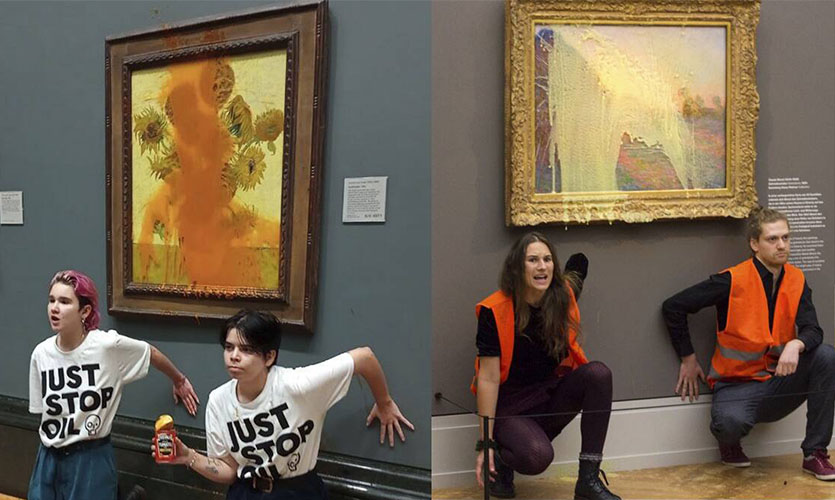“What is worth more, art or life? Is it worth more than food? More than justice? Are you more concerned about the protection of a painting or the protection of our planet and people?” cried a Just Stop Oil activist as she splashed tomato soup all over Vincent van Gogh’s ‘Sunflowers’ painting at the National Gallery in London.
Since Europe has fallen prey to the worst droughts and wildfires that have badly hit its economy, climate activists are leaving no stone unturned in raising awareness of the severity of the climate crisis, and the need to end the use of fossil fuels causing it.
Just Stop Oil had earlier blocked traffic on central London roads with their sit-down protests. But their dissent against the climate crisis has now taken a bizarre shape.
The protest stirred a mix of emotions in the gallery; while some gasped, some shouted angrily. Overall, it continues to spark dialogue about climate change and reducing the use of fossil fuels.
However, does destroying art justify protesting against the environment? Is it a valid means to a favourable end?
The Art Attack Legacy
Destruction of art to grab attention is not a recent tactic, as it has always been an expression of political commentary.
Johannes Vermeer’s beloved masterpiece ‘Girl With a Pearl Earring’, kept at the Mauritshuis museum in The Hague, was another victim at the hands of such protesters. A member from Just Stop Oil superglued his head to the painting and doused it in red goo.
Meanwhile, two activists from the group Letzte Generation (Last Generation) smeared mashed potatoes on ‘Les Meules’, or Haystacks, which was painted by Monet in 1890 and is displayed at Das Museum Barberini in Germany. They crouched beneath the work and glued their hands to the wall like the protesters in London.
Tomato soup, mashed potatoes, red goo… this protest is anything but appetising.
Tensions died down slowly when it was discovered that the paintings were protected by glass and remained undamaged. Activists at London’s National Gallery claimed that they were aware that the painting would not be destroyed. Even so, that did little to kill the controversy.
Destroying Paintings Cannot Save The World
Did it really make sense to vandalise (even if temporarily) great works of art as a way to draw attention to the climate catastrophe?
The activists have made a valid argument that pushing cultural buttons does more to provoke, challenge and shock. It pushes people to ponder what we should protect. Should it be the conditions that allow humanity to make art and to be creative? Or the masterpieces that will have no one to gaze on them soon? The outburst served as a wake-up call for people living comfortably in their homes, oblivious to the impending end of the world.
The question of whether tampering with and potentially damaging priceless works of art benefits or harms the climate has dominated much of the discussion. Studies propagated by some political and climate analysts claim that bringing attention to the problem and strengthening this movement could garner more support for the climate and subsequently more moderate climate activists. However, some studies that suggest it might backfire by alienating potential supporters have been flagged by others.
Nonetheless, one can easily spot hypocrisy in this activism. While the protesters are supposedly fighting to save the world and the ecosystem, they are also wrongfully wasting food in proving a point, negating their message. The resources on our planet are undeniably limited, as asserted by the activists themselves. What makes splattering food right but using oil wrong?
It is fairly easy to make headlines by making compelling speeches and making people think about issues by spilling food and ruining artwork. But are these people actually making strides in reducing carbon emissions themselves?
The incident has led to a great deal of outrage in the art community. Das Museum Barberini founder Hasso Plattner talked about how it would be challenging to find a lender for future exhibitions if such acts continue to threaten the art community. In an already dying legacy, such protests seem to add only insult to injury. The museums can only sometimes make the ends meet to finance high-level security for the paintings and their insurance.
Protesting the climate crisis and asking people to choose whether they care more about the environment or the art is like comparing apples to oranges. Sure, one can deeply care about saving the planet, but vandalising precious paintings is bound to agitate people and potentially reduce support for such fanaticism!
Destroying an artwork in the name of activism doesn’t fit the crime, and only harms the cause.










